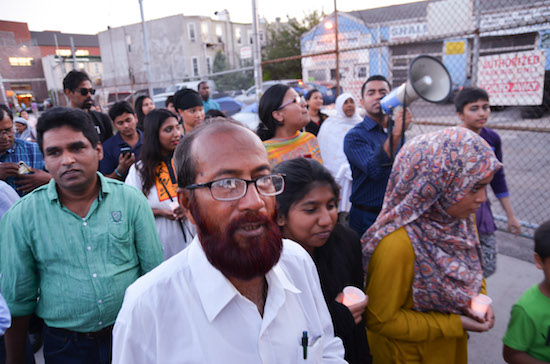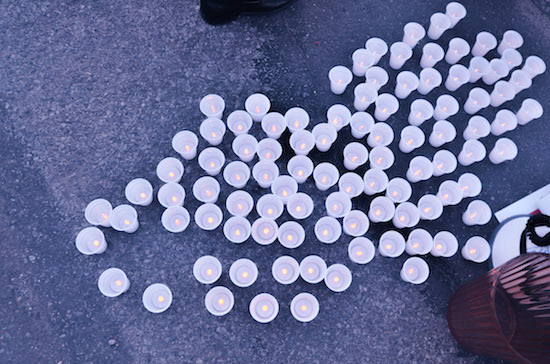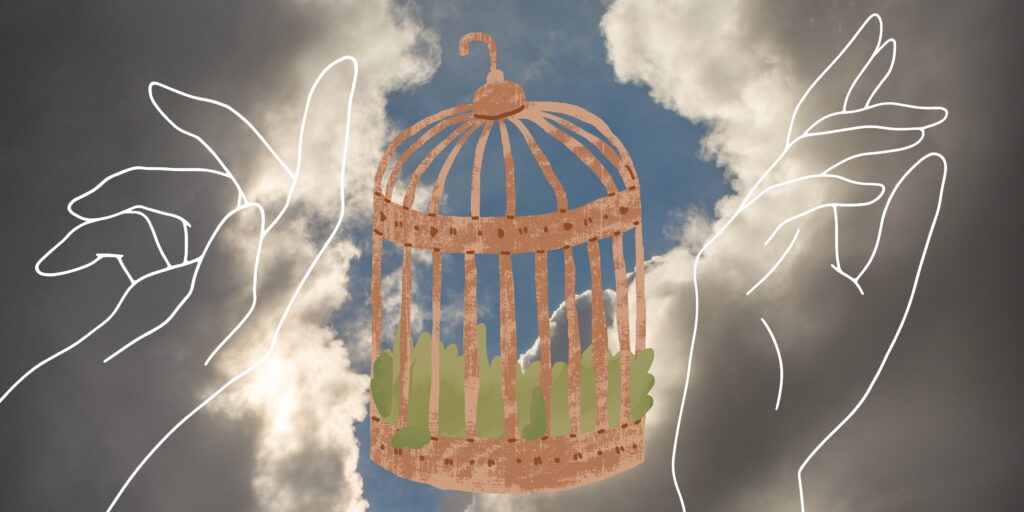In Kensington, young Bangladeshi activists fight against apathy and inaction in the local community by organizing around the murder of a 13-year-old boy in Bangladesh earlier this summer.

September 2, 2015
Along its way south toward Avenue C in Kensington, McDonald Avenue splits, its two way traffic divided by the massive geometric MTA structure erected last year. At the intersection, and kitty-corner from the Baitul Jannah Jame Masjid Center & Muslim Community Center, sits a large concrete triangle, a space that City Council Member Brad Lander says is going to be transformed into a plaza with benches, tables, and greenery. For now it goes mostly unused. It’s here that a group gathered on August 4, megaphones hanging by their sides, small plastic cups with flameless LED tea lights set on the pavement, and the corners of a large banner held in their pinched fingers with a message in Bangla and then in English, in bold letters: “VIGIL FOR RAJON” and “STOP VIOLENCE AGAINST CHILDREN ACROSS THE WORLD.”
The sparse crowd, comprising mostly Bangladeshis and Bangladeshi Americans, came out to stand for justice in the brutal death of 13-year-old Samiul Alam Rajon. On July 8, Rajon was attacked by a gang of men in the northeastern city of Sylhet in Bangladesh after they accused him of stealing a bicycle. A video that was uploaded to the Internet and went viral shows the gruesome assault, in which the mob tied the boy to a tree and beat him as he pleaded for his life.
Demonstrations broke out in Sylhet, Dhaka, and other major cities in the following days. After weeks of silence on the streets around Brooklyn’s “Banglatown,” as well as minimal coverage in the U.S. media, a handful of young Bangladeshi activists of the diaspora took it upon themselves to organize locals in a collective stance against the murder. On the morning of the vigil, news came out of another similar incident, the torture and killing of 12-year-old Rakib Hawlader in the city of Khulna. Since then, the lynchings of two more youth, Robiul Awal, 10 and Mohammad Raja, 17, made headlines. Protests around Bangladesh have grown in size and intensity.
“We are the largest Bangladeshi community in the U.S. here in New York,” said Shahana Hanif, one of the organizers of the action. “Yet when there are issues that occur at home there is no sense of unity that brings us together or that lets us speak out and take a stance that’s not the normal one.”

By ‘normal’ in this case, Hanif said she means apathy and inaction. Born and raised in Kensington, she said she has never seen any kind of organizing or mobilization of people in the neighborhood take place in response to injustice within the global Bangladeshi community. She heard that a few people stood outside of the Walgreens on Church Avenue to protest the conditions that led to the April 2013 collapse of Rana Plaza, a commercial building with garment factories in Dhaka, but was unaware of it at the time.
Taking things into their own hands, Hanif and three others—Farhat Rahman, Fahmida Azad, and Ifte Chowdhury, all Brooklyn-based twenty-something activists of Bangladeshi descent—planned a twilight vigil for Rajon. But, as Hanif explained, its purpose extended beyond fighting to end the abuse of children: on a deeper level, its goal was incite outrage in the community more generally, to “get them agitated by how normal it is for a child to die and there not be any action whatsoever,” she said. “This to me says we don’t give a f*ck; we don’t care at all.”
The four organizers had initially hoped to do something similar in the wake of the recent spate of killings of atheist bloggers in Bangladesh, which got more visible outrage in the media. They scrapped this idea as a starting point due to the sensitivities and political rifts of the neighborhood.
“The community is predominantly Muslim and we were surrounded by five masjids—if you come across too radical, it’s harder to build relationships,” Hanif said.

As the sun dipped behind a large brick warehouse across the street from Desi Bazaar Inc. Supermarket, the pack of protesters thickened. Some trickled in from the direction of the train, a planned stop at the end of their day; others were pedestrians passing by, drawn to the rare spectacle by curiosity.
“I was going for prayer when I saw Rajon’s picture over here,” 57-year-old Mohammad Haq said. “That’s why I came over here for a silence minute. What happened is very pathetic. So I came here to show sympathy for the young child.”
Haq has lived in Kensington for seven years. He said he doesn’t feel that he and his neighbors can do anything, but that he hopes the government of Bangladesh punishes the attackers and brings justice to Rajon’s family.
“After that, nobody try to do the beating and killing to the child,” he said.
The issue of violence against children is close to the community at this moment, as people in the area continue to process the fatal July stabbing of a Kensington man by his 19-year-old son, Hassan Razzaq, in their East 3rd Street home. It was widely known that the father was abusive to his kids and wife for years; neighbors have been rallying in support of Razzaq, who is facing 25 years to life in prison, hoping for leniency from the court. A Change.org petition was created for him, but little has been done in Kensington itself.
Along with the moment of silence for Rajon, the organizers, Councilmember Lander, and a few others made remarks to the crowd. Speaking loudly from the base of the triangle, they asked for everyone to pull in tighter. Men, hands clasped or arms folded, stepped closer, creating an arc. Women, with scarves draped over their heads and shoulders, completed the other half of the semicircle. Hanif, Rahman, Azad, and Chowdhury spoke in Bangla first.
“The tendency to view marginalized people—women, children, LGBT and disabled peoples—as beneath us has culminated in the tragic death of Rajon,” Rahman said, horn in one hand, typed sheets of Bangla words in Roman script flapping in the other. The faces around them were somber as they and the others touched on the broader context that allowed such an incident and others like it to take place, and for them to occur with impunity.
“The perpetrators did not see Rajon as human, rather they saw him as disposable, a life without any meaning or value due to meager economic and social means,” Rahman continued. “And frankly, that is the way class and caste has always operated throughout Bangladesh and South Asia, where people who belong to the lower spheres of society are seen as subhuman.”

With an unspoken nod to the silent acceptance of the known violence in the Razzaq home—as well as in many others—Azad built upon the theme of the need to shatter societal attitudes: “It’s important to recognize that these extreme cases of abuse often have a breeding ground, and that a climate like this does not happen overnight. It’s important to reflect on the spectrum of abuse and how we all, intentionally or unintentionally, often play a role in creating this climate.”
Hanif said that in doing outreach leading up to the vigil, for which she posted flyers in Bangla around Kensington, some of these interconnected cultural issues were brought to light. As a woman, she felt she was pushing back on the expectation that she and other young woman would not take up public space in the community.
“Men loiter—men take claim of the space,” she said. “It’s something that’s unspoken, but it’s very male-dominated and it’s very threatening. So when we were doing street outreach, I was so, so scared. It’s not like I felt they would attack me, but there was such an intimidation factor of breaking into a crowd of men who are usually the same ones who will catcall and the same ones who you know are judging you for coming home at 12 or 1.”

The process of putting together a vigil in Banglatown was in itself an act of resistance. On top of the tradition of women not staking claim to public spaces in the neighborhood, young people have thus far not been leaders in the community, Hanif said. The leaders are older men who have created cultural, religious, or business associations. And one individual, when approached about the vigil, expressed a shared skepticism in the community, asking: “What would be the point of this?” Political activism led by four young people, two of them women and one who is gender non-conforming, is a drastic shift in the ways of their small world.
Hanif said they had expected 20 people at most. But the hundred or so bodies that showed up—some from Bangladeshi neighborhoods in other boroughs and ranging from small children to the elderly—marched up McDonald Avenue to Church Avenue and back, passing South Asian grocery stores, hair salons, and restaurants. They chanted in Bangla: “We want answers for Rajon! We want answers for Rakib!” Business owners and patrons came out to the street, throwing their fists up and joining the chant.
“I think one of the most alienating things about growing up as diasporic children in New York is that we don’t really have Bangladeshi-centered organizing tactics that are actively recruiting Bangladeshis,” Sharmin Hossain, who grew up in Queens, said as she marched. “To be here means that we don’t believe in other people saving us—we have to save each other.”
Hanif said that the evening revealed to her that Kensington is not only ready for change but also ready for its youth to carry the torch. Her father, who has been a Kensington resident for 31 years, said he has never seen a march in the neighborhood or seen the second generation take on such an active role.
“I am proud of her for organizing this,” Muhammed Hanif said. “She is born America and I am proud because she understands what’s going on in Bangladesh and all over the world. A lot of people don’t realize. To see the young people think about their parents’ country and respond—it’s good.”
On September 16, the Brooklyn Book Festival, Roulette, and PEN American Center are hosting an event to commemorate the bloggers murdered in Bangladesh this year, and to protest the threat looming over more than 70 other Bangladeshi intellectuals, many of whom are in hiding. Click here for more information.



